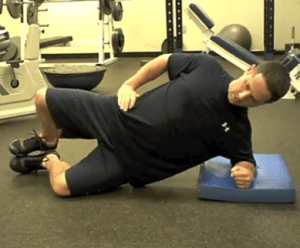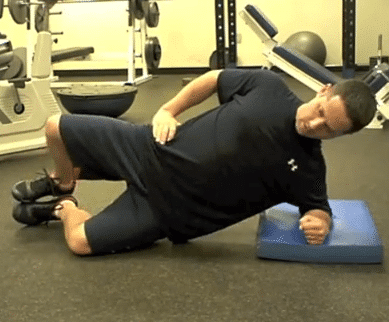 There is no doubt that the core and pelvis intricately work together to produce spine and pelvic mobility and stability. Most of us tend to focus on both core stabilization and hip mobility and strength separately, at least initially in the program. But we should also consider working them simultaneously.
There is no doubt that the core and pelvis intricately work together to produce spine and pelvic mobility and stability. Most of us tend to focus on both core stabilization and hip mobility and strength separately, at least initially in the program. But we should also consider working them simultaneously.
In this model, I tend to emphasize exercises that require core stability and hip strengthening exercises. This is a major concept in what I have always referred to as Functional Stability Training (get ready, you are going to be hearing that a lot more from me in the next several months). Many of the basic exercises we already routinely perform achieve this goal, even if indirectly. Bird dogs and bridges come to mind, for example. Both exercises require core stabilization while performing hip movements, although fairly basic in regard to challenge.
Side Plank Hip Abduction Exercise
Recently I have seen the incorporation of side planks and hip abduction on various websites around the web. That is a great example of the type of Functional Stability Training i am referring to here, simple stated:
[box]Train the core to stabilize while simultaneously incorporating hip mobility and strengthening exercises[/box]
Performing side lying hip abduction from a side plank position achieves this well. However, I should note that I see many people recommending that we perform this up against a wall. By doing this, you essentially are putting training wheels on the exercise and using the wall to help perform the side plank and abduction movements with proper form. To me, if you need the wall, you are not ready for the exercise.
This simultaneous incorporation of spine stability and hip mobility is not a beginner exercise. One should be able to perform each exercise perfectly as individual exercises prior to performing them together.
Side Plank Clam Shell Exercise
In addition to the side plank and hip abduction exercise, I also often perform a side plank and clam shell exercise. I have talked about the many benefits of the hip clam shell exercise and why I think it is so important to include in our programs. This is the next progression of the exercise in my mind, but in order to perform it well, you need to master both the clam shell exercise and the side plank exercise.
Video of the Side Plank with Hip Clam Shell and Abduction
Here is a video demonstration of the side plank with hip clam shells and with hip abduction exercises:
Here is another view of the side plank with clam shell exercise from my friend Masai Takahashi, who showed me how he likes to incorporate the clam shell into his side planks. He is pretty advanced and includes a resistance band around his knees:
A few things to notice in the video:
- The clam shell exercise is performed while performing the side plank from the knees, making this one a little easier at first and probably a good place to start. Not that when performing the side plank from the knees, you need to make sure your hips move forward and your body is in alignment, as Masai demonstrates well.
- The hip abduction exercise is performed with the legs straight.
- The most important aspect of these exercises is maintaining core stability. Your body should perform the plank and be able to keep the core stabilized. If you can’t keep your form during the plank, you shouldn’t progress to include hip movements.
- The second most important aspect is to assure you are using good hip form without compensating by rotating or losing core stability.
- These exercises can be progressed by added weight or resistance bands around the legs
Remember, these exercises are not for beginners. They require pristine form on both the side plank and hip exercises individually. This is a key component to Functional Stability Training:
[box]If you can not perform these exercises individually, you should not progress to perform them simultaneously.[/box]
Try the side plank exercise with hip clam shells and hip abduction exercises, I think you’ll be surprised at how challenging this is for both core stability and hip strengthening.





